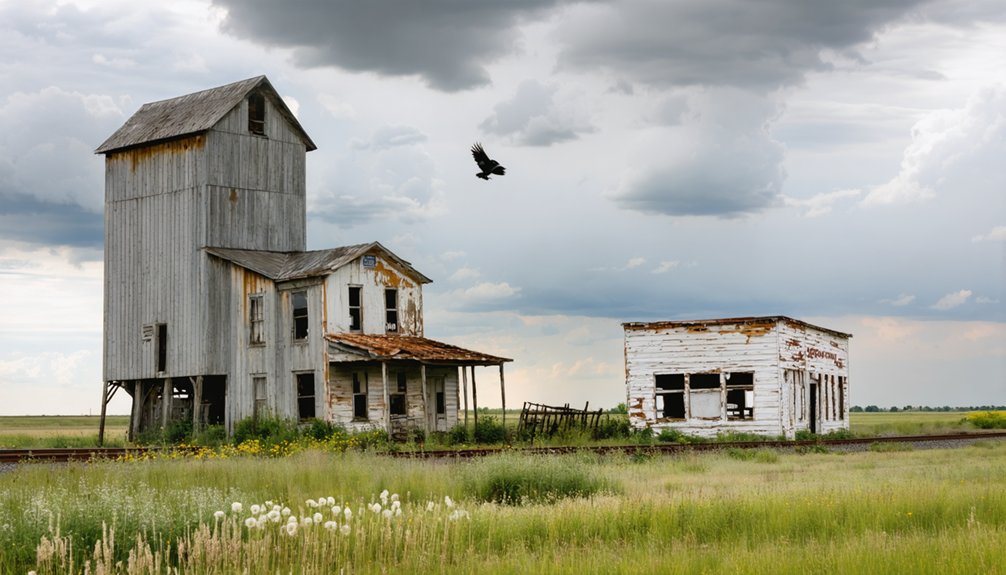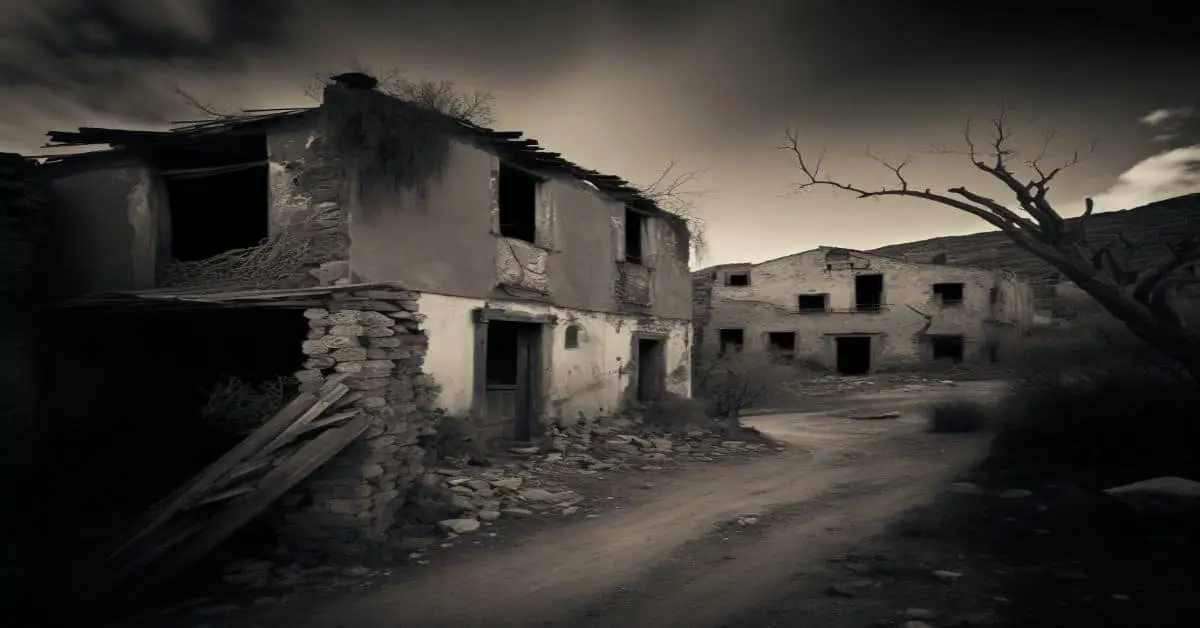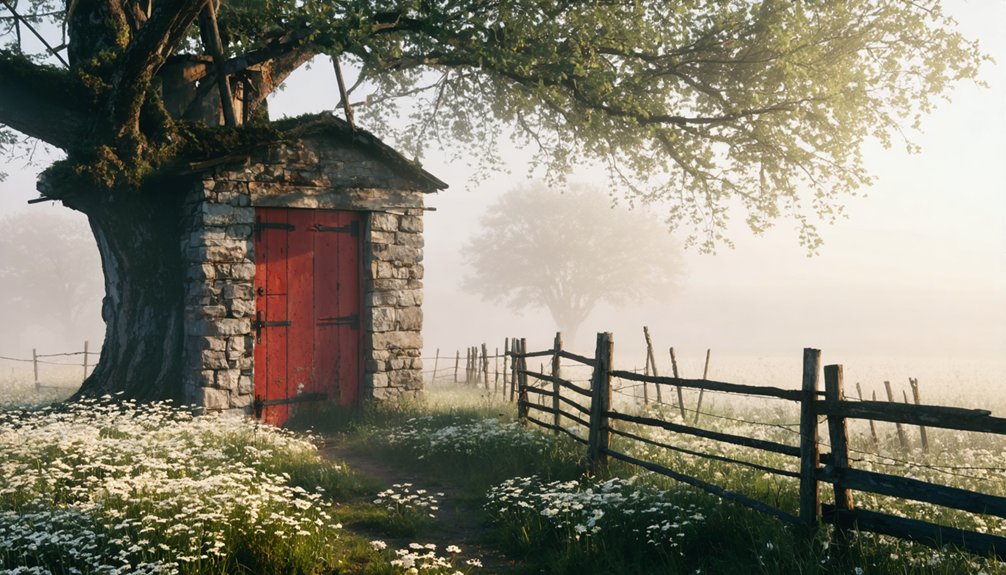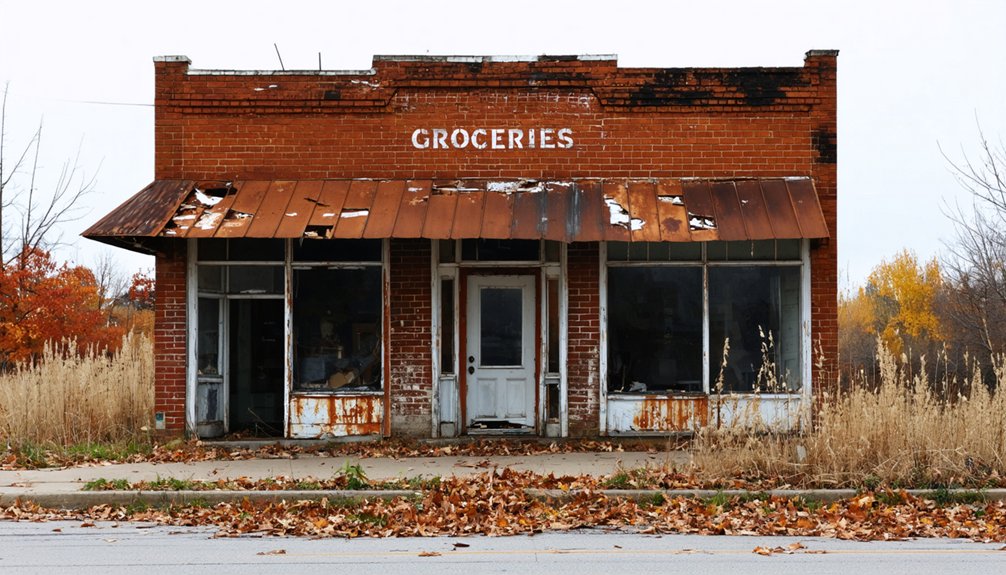You’ll discover Rockville’s ruins along the Maquoketa River in Delaware County, Iowa, where a bustling mill town once thrived in the late 1800s. The community grew around water-powered mills, limestone quarries, and hotels that served farmers and traders from up to 20 miles away. When promised railroad connections never materialized, Rockville gradually faded. Today, you can explore the old stone mill ruins and historic cemetery where 200 souls, including Civil War veterans, rest. The town’s untold stories linger beneath the natural overgrowth.
Key Takeaways
- Rockville was a thriving 19th-century trading hub in eastern Iowa that declined after railroad companies abandoned expansion plans.
- The town’s economy centered around water-powered mills along the Maquoketa River, producing lime, wool, and processed grain.
- Historical remnants include stone mill ruins, scattered building foundations, and a cemetery with approximately 200 burial sites.
- Three hotels, multiple stores, and a post office (closed 1898) once served traders and travelers along the Dubuque stagecoach route.
- The Rock Island Railroad’s bankruptcy in the 1970s led to Rockville’s economic isolation and eventual transformation into a ghost town.
The Rise of a Frontier Settlement
Before Rockville emerged as a frontier settlement, the land belonged to various Indigenous nations including the Meskwaki, Sauk, Ioway, and Sioux peoples. Through a series of treaties and forced removals between 1832 and 1852, the U.S. government cleared the way for Euro-American settlement.
You’ll find that settler experiences in Rockville mirrored those of other Iowa frontier communities in the mid-1800s. Early settlers faced community challenges as they established their claims through the federal land offices. The earliest homestead claims were made by Jack Smith and Wilson. The fertile soil and abundant harvests of exceptional crops drew many homesteaders to the area.
Life on the Iowa frontier followed familiar patterns as settlers navigated federal claims and forged new communities.
They’d often arrive from states like Illinois, Indiana, and Ohio, seeking fertile farmland to build their future. Religious leaders, like Methodist ministers, played significant roles in organizing the first community gatherings.
Together, settlers worked to establish essential institutions – churches, schools, and post offices – transforming the raw frontier into an organized settlement.
Life Along the Maquoketa River
You’d find the Maquoketa River bustling with activity in Rockville’s heyday, as settlers harnessed its flow to power sawmills and gristmills essential to the town’s economy.
The river’s rich ecosystem, with its abundant fish and wildlife, provided sustenance for the growing community while supporting agricultural development in the fertile valley.
Local families gathered at the riverside for fishing, water collection, and social activities, making the Maquoketa a central feature of daily life in this frontier settlement.
The river’s course through steep Silurian dolomite cliffs created dramatic scenery that became a defining characteristic of the landscape around Rockville.
The blue-green hue of the clear waters added to the natural beauty that drew people to settle along these banks.
River Industry Thrives
The Maquoketa River‘s mighty waters fueled a remarkable industrial boom in Rockville during the late 19th century, transforming this small settlement into a thriving economic powerhouse.
You’d find bustling river commerce along the banks, where limestone quarries, woolen mills, breweries, and furniture makers took advantage of the abundant water resources.
Alfred Hurst’s limestone empire led the charge, with his kilns producing an impressive 8,000 barrels of lime daily. The high-quality limestone deposits along the Maquoketa River made the area ideal for lime production. Workers processed limestone in kilns burning at 900 degrees Celsius to create the valuable lime products.
The river’s strategic location attracted diverse industries, while the Maquoketa and Hurstville Railroad, built in 1888, connected local businesses to wider markets.
Workers earned top wages of $1.25-$1.35 per day, and the industrial growth created year-round employment opportunities.
From brick makers to cigar manufacturers, you’d witness a vibrant economy that flourished along these productive waters.
Daily Riverside Activities
Beyond the industrial bustle, life along the Maquoketa River offered residents a rich tapestry of daily activities that shaped their community bonds.
You’d find locals gathering along the limestone cliffs and riverbanks for picnics, while others cast their lines into the water hoping to catch native Iowa fish. The river activities weren’t just about leisure – they connected people to their heritage, from the Native American tribes who first called these waters home to the settlers who built their lives here. Recent clean-up and archaeology paddles organized by experts have helped preserve both the natural beauty and historical significance of these waters.
The area became a cherished spot for social gatherings, where a dance pavilion built in 1868 hosted community events near the Natural Bridge. Whether you wanted to explore the caves that hosted community dances, trek along riverside trails through oak forests, or paddle downstream in a canoe, the Maquoketa provided endless outdoor recreation opportunities.
These daily riverside pursuits helped forge lasting connections between neighbors and nature.
Milling Heritage and Economic Growth
If you’d visited Rockville in the mid-1800s, you’d have witnessed the construction of a substantial water-powered mill along the North Fork Maquoketa River, where local settlers harnessed the river’s flow to process grain and lumber.
The reliable water power attracted farmers from up to 20 miles away, transforming Rockville into a bustling commercial center with three hotels, multiple stores, and essential services. A vital post office operated until May 31, 1898, serving the town’s growing population. The town once served as a major stagecoach stop in Delaware County, helping connect travelers and goods across the region.
As word spread of the mill’s capabilities, Rockville quickly grew into one of eastern Iowa’s most important trading hubs, where the rhythmic sounds of grinding grain and sawing timber marked the community’s economic heartbeat.
Mill’s Early Construction Days
During the mid-1840s, Rockville’s pioneering settlers recognized the North Fork Maquoketa River‘s potential for powering a mill complex. You’ll find they chose this location strategically, using proven construction techniques to build both a grist mill and sawmill that would serve the region’s growing needs.
The mill structure’s development followed three essential steps:
- Selection of a reliable water flow location along the Maquoketa River
- Implementation of stone construction methods that proved durable enough to partially survive to present day
- Installation of period-typical milling technology that could process both grain and lumber
This ambitious project transformed Rockville into a significant economic hub, drawing settlers from up to 20 miles away who’d bring their grain for processing, often staying overnight while waiting for their turn at the mill.
Water Power Drives Growth
While Rockville’s initial mill construction laid the foundation, it was the sophisticated water power infrastructure that truly catalyzed the town’s economic transformation.
You’ll find that early mill owners cooperated extensively on water management, regulating river flow to guarantee every operation received its fair share. The installation of gravity-fed distribution systems and cement-lined pipes revolutionized both industrial and domestic water supply.
As milling technology evolved, you’d see the shift from traditional waterwheels to more efficient iron mixed-flow turbines by the 1870s.
Oliver Evans’ automatic mill design brought unprecedented efficiency through mechanical grain elevators and gravity feed systems. These innovations weren’t just about grinding flour – they powered everything from sawmills to wool processing operations, creating jobs and attracting new businesses that would shape Rockville’s industrial landscape.
Trading Hub Development
The strategic placement of Rockville along the stagecoach route from Dubuque made it a bustling commercial nexus in eastern Iowa’s early development.
The town’s trade dynamics centered around its water-powered mill, which drew farmers from up to 20 miles away, creating a vibrant marketplace for community interaction and commerce.
You’d find these crucial elements driving Rockville’s success:
- Three hotels accommodating overnight traders and travelers
- Multiple stores and a post office serving as communication hubs
- A wagon shop and various artisanal businesses supporting the local economy
The concentration of commercial activity transformed Rockville into one of eastern Iowa’s most significant trading points.
You couldn’t miss the constant flow of farmers, merchants, and travelers who gathered here, establishing crucial networks that connected neighboring communities and fostered regional growth.
The Railroad That Never Came
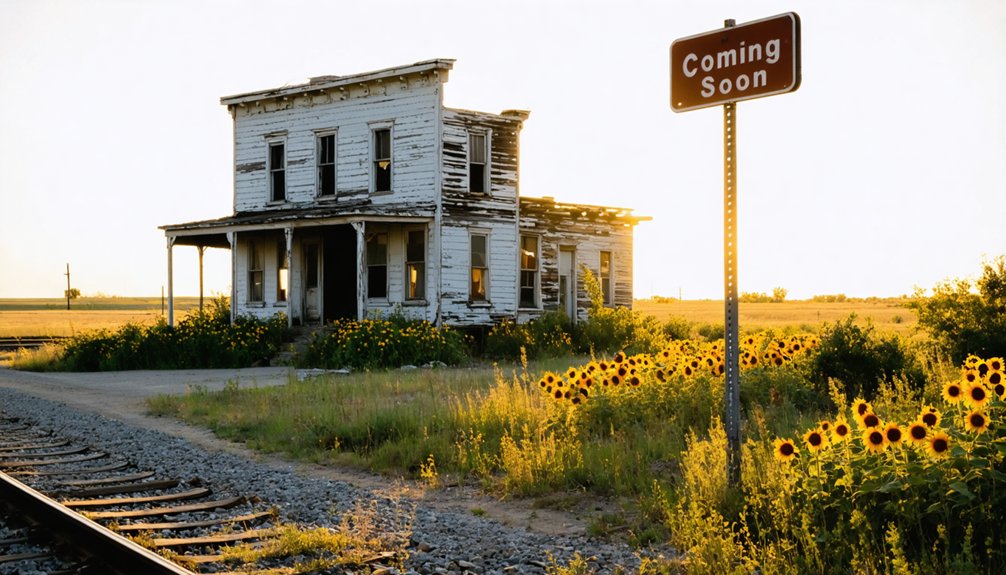
How different might Rockville’s destiny have been if promised railroad connections had materialized?
During the late 19th and early 20th centuries, railroad promises painted an optimistic future for your small Iowa town. The Chicago and North Western Railroad, along with the Rock Island line, competed to extend their networks into western Iowa’s grain markets.
But those dreams never became reality.
The economic impact proved devastating when major railroads abandoned their expansion plans. Rock Island’s eventual bankruptcy in the 1970s permanently sealed Rockville’s fate.
The death knell for Rockville came when railroads abandoned expansion plans, leaving the town stranded in economic isolation.
Without rail access, your town’s grain cooperatives lost direct shipping options, while neighboring communities with railroad connections flourished.
As businesses and residents gradually departed, Rockville’s isolation from crucial transportation networks ultimately contributed to its transformation into a ghost town.
Remnants of a Lost Community
Standing as silent witnesses to Rockville’s vibrant past, several haunting remnants still dot the Iowa landscape today.
You’ll discover the old stone grist mill ruins along the Maquoketa River, where local farmers once gathered to process their grain. The historic Rockville Cemetery, with its approximately 200 burial sites, preserves the community’s burial traditions and sparks ghost stories among visitors.
If you’re exploring these lost places, you’ll find:
- Civil and Mexican War veterans’ graves among the wooded cemetery grounds
- The damaged but enduring stone mill structure, once powered by the river’s flow
- Scattered building foundations hidden beneath years of natural overgrowth
While wooden structures have vanished, these remaining features tell the story of a once-thriving community that time hasn’t completely erased.
Legacy in Delaware County
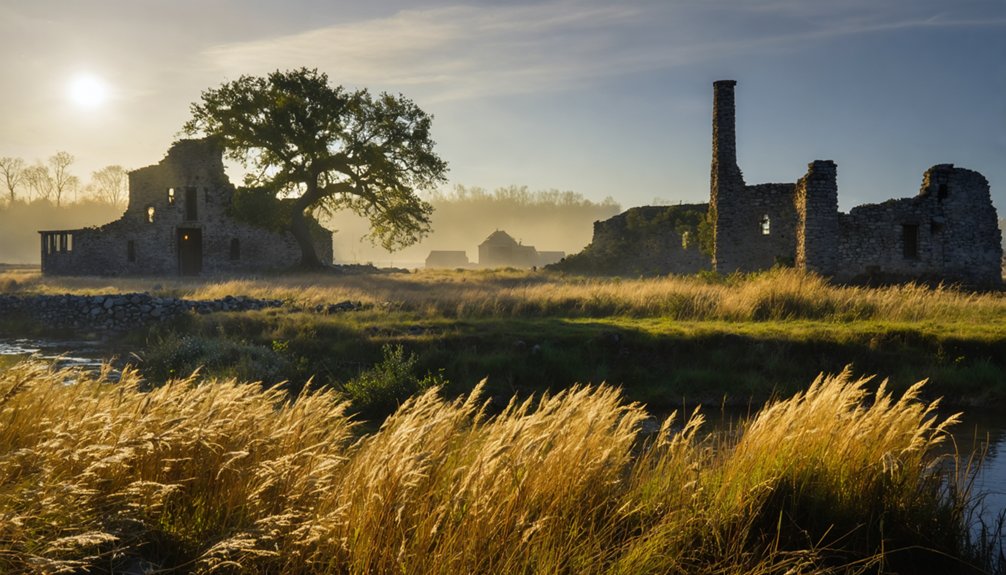
Although Rockville now exists only in memories and scattered ruins, its influence on Delaware County’s development remains significant.
You’ll find its historical significance embedded in the area’s trading heritage, where it once served as a crucial stagecoach stop and mill point second only to Delhi in importance.
The town’s cultural impact lives on through its role in early Iowa settlement patterns.
When you explore the region today, you’ll discover how Rockville’s strategic location along the North Fork Maquoketa River helped shape local commerce until the late 19th century.
While the railroad’s rerouting ultimately led to its demise, Rockville’s legacy endures in historical records and maps.
The old cemetery stands as a monument to the community’s pioneering spirit and determination in Delaware County’s formative years.
Frequently Asked Questions
Are There Any Paranormal Activities Reported at the Rockville Cemetery?
You won’t find documented ghost sightings or haunted tales specifically tied to the cemetery, though its eerie hilltop setting and abandoned surroundings might explain why locals feel unsettled there after dark.
How Many Families Remained in Rockville After the Post Office Closed?
You won’t find exact family demographics after 1898’s post office closure. Historical records suggest minimal families remained as town decline forced most residents to relocate to Delhi and Dyersville for better opportunities.
What Happened to the Original Town Records and Documents?
Ever wonder what vanished history tells us? You can’t trace Rockville’s original documents because there’s no record of historical preservation efforts. Floods, abandonment, and the town’s decline likely destroyed these essential records.
Can Visitors Legally Explore the Remaining Mill Ruins Today?
You’ll need landowner permission to legally explore the mill ruins, as they’re on private property. Follow exploration guidelines and respect access restrictions while viewing this historical structure.
Were There Any Notable Crimes or Tragedies in Rockville’s History?
You won’t find any unsolved mysteries or historical hauntings here – records show no significant crimes or tragedies. The town’s decline came simply from economic changes when the railroad bypassed it.
References
- https://www.findagrave.com/cemetery/2374194/rockville-cemetery
- https://www.dmcityview.com/commentary/ask-cityview/2024/05/01/ask-cityview-21/
- https://www.youtube.com/watch?v=1J0Qx64ZrwI
- https://www.youtube.com/watch?v=eh_YlgRKjBU
- https://jackandkitty.com/iowa-ghost-towns/
- https://www.geocaching.com/geocache/GC12D7A
- https://en.wikipedia.org/wiki/Rockville
- https://www.onlyinyourstate.com/experiences/iowa/ia-ghost-town
- https://iowaonline.uni.edu/prairievoices/images/Time_Periods.pdf
- https://www.cityofrockvalley.com/history
